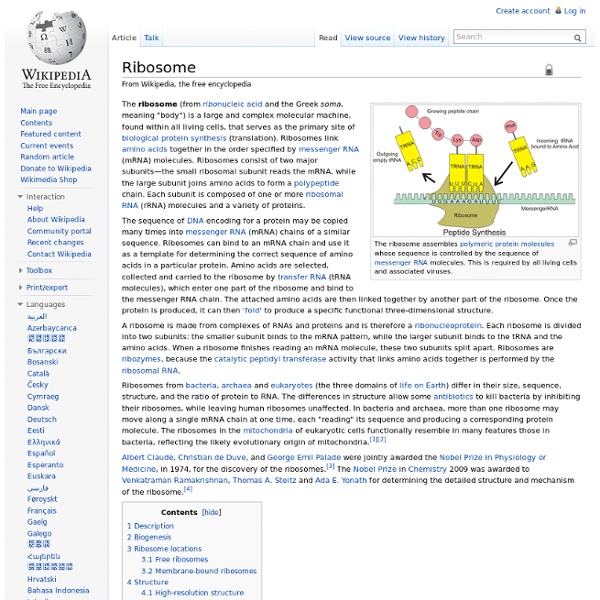Detailed view of a crucial enzymatic complex revealed
Researchers led by ETH professor Nenad Ban have now completed the three-dimensional structure of the ribosome from a higher organism. This structure will increase the understanding of this cellular “protein factory” and facilitate the development of novel drugs. The machinery that reads genetic information within a cell and translates it into corresponding proteins, the so-called ribosome, is among the most complex cellular enzymes known in biology. In higher organisms such as fungi, plants and animals (so-called eukaryotes), the ribosome is even more complex than in bacteria. Towards a better understanding of the ribosomal function Comparing the ribosomal structures of both, bacteria and higher organisms, will enable scientists to develop novel specific pharmaceutical compounds against pathogens and pests. Ribosomes of higher organisms have been a major focus at the laboratory of Prof. Reference:
Nenad Ban's scientific work is regarded as a milestone in biochemical research
Professor Nenad Ban, distinguished Croatian scientist ETH Professor Nenad Ban, Timm Maier, Marc Leibundgut and Simon Jenni (left to right) were so successful with their work on the structural analyses of fatty acid synthases in mammals and fungi that they had two publications in the same issue of "Science".See The architecture of fatty acid factories. Professor Nenad Ban and his research group - The Ban Lab, ETH, Zurich, Switzerland 2010. Older photos. Thomas A. Formated for CROWN by prof.dr.
The melanoma epidemic? Don't panic it's all a terrible mistake
By Professor Sam Shuster Updated: 09:20 GMT, 10 August 2010 Summer is a marvellous time. And, of course, it's also holiday time. But in recent years our delight in the sun has been clouded by bullying health warnings. Don't cover up all summer: Some exposure to the sun is good for you Health organisations that should know better, but rarely do, would have us shun the all-too-short glory of our summer days. Next, they'll even be ordering us to shut our curtains during the hours of daylight! As a result, the killjoys spread their terrifying message, and parents are made to feel unreasonably guilty if they as much as let their children out in the sun unprotected for a minute or two. But if all this miserable propaganda has got you scared and worried, you shouldn't be. Because the evidence is that the message promoted by the anti-sun brigade isn't true. This ageing loss occurs at the same rate of one per cent a year whether your skin is exposed to the sun or whether it isn't.
Is sun exposure a major cause of melanoma? No
Sam Shuster, honorary consultant Author Affiliations sam@shuster.eclipse.co.uk Every summer we are reminded about the dangers of the sun. Scott Menzies (doi: 10.1136/bmj.a763) argues that the risks of malignant melanoma are real, but Sam Shuster is unconvinced The list of harmful things grows daily, freshly mined by descriptive epidemiology, a substitute for research that confuses association with cause. There is solid descriptive, quantitative, and mechanistic proof that ultraviolet rays cause the main skin cancers (basal and squamous).
Disappearing Needles: Vaccine-Delivery Patch with Dissolving Microneedles Eliminates “Sharps” Waste and Improves Protection « Georgia Tech Research News
A new vaccine-delivery patch based on hundreds of microscopic needles that dissolve into the skin could allow persons without medical training to painlessly administer vaccines – while providing improved immunization against diseases such as influenza. An array of 36 dissolving microneedles is shown here on a fingertip for size comparison. (Click image for high-resolution version. Credit: Jeong-Woo Lee) Patches containing micron-scale needles that carry vaccine with them as they dissolve into the skin could simplify immunization programs by eliminating the use of hypodermic needles – and their “sharps” disposal and re-use concerns. Details of the dissolving microneedle patches and immunization benefits observed in experimental mice were reported July 18th in the advance online publication of the journal Nature Medicine. An array of 100 dissolving microneedles is shown here on a U.S. penny coin for size comparison. Writer: John Toon Be Sociable, Share!
Microneedles May Make Getting Flu Shots Easier
WASHINGTON — One day your annual flu shot could come in the mail. At least that's the hope of researchers developing a new method of vaccine delivery that people could even use at home: a patch with microneedles. Microneedles? That's right, tiny little needles so small you don't even feel them. Researchers led by Mark Prausnitz of Georgia Institute of Technology reported their research on microneedles in Sunday's edition of Nature Medicine. The business side of the patch feels like fine sandpaper, he said. Some medications are already delivered by patches, such as nicotine patches for people trying to quit smoking. In the Georgia Tech work, the vaccine is still injected. So two problems are solved right away – fear of needles, and disposal of leftover hypodermic needles. "The goal has been a means to administer the vaccine that is patient friendly," Mark R. Flu vaccination is recommended for nearly everyone, every year, and that's a big burden on the public health network, Prausnitz noted.



